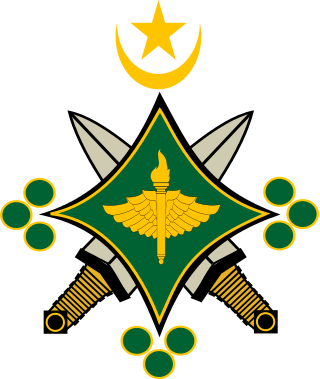
The Armed Forces of Mauritania is the defence force of the Islamic Republic of Mauritania, having an army, navy, air force, gendarmerie, and presidential guard. Other services include the national guard and national police, though they both are subordinated to the Ministry of the Interior. As of 2018, the Mauritanian armed forces budget was 3.9% of the country's GDP.

Nouakchott is the capital and largest city of Mauritania. Located in the southwestern part of the country, it is one of the largest cities in the Sahara. The city also serves as the administrative and economic center of Mauritania.
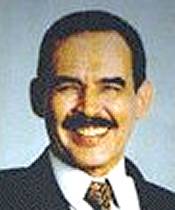
Maaouya Ould Sid'Ahmed Taya is a Mauritanian military officer who served as the President of Mauritania from 1984 to 2005. During his presidency, he pursued policies of Arab nationalism while deepening ties with the United States.

Moktar Ould Daddah was a Mauritanian politician who led the country after it gained its independence from France. Daddah served as the country's first Prime Minister from 1957 to 1961 and as its first President of Mauritania, a position he held from 1960 until he was deposed in a military coup d'etat in 1978.
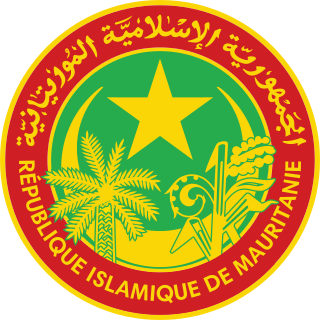
The Military Council for Justice and Democracy was a supreme political body of Mauritania. It served as the country's interim government following the coup d'état which ousted the President Maaouya Ould Sid'Ahmed Taya on 3 August 2005. It was led by the former Director of the national police force, Colonel Ely Ould Mohamed Vall. After seizing power, it quickly pledged to hold elections within two years and promised that none of its own members would run.

Tiris al-Gharbiyya was the name for the area of Western Sahara under Mauritanian control between 1975 and 1979.

Messaoud Ould Boulkheir is a political figure from Mauritania and a leader in the Haratine community. Messaoud also contributed towards the end of the 1989 events in Mauritania, protecting the right of the victims and the emancipation of the Haratine in Mauritania with his party.
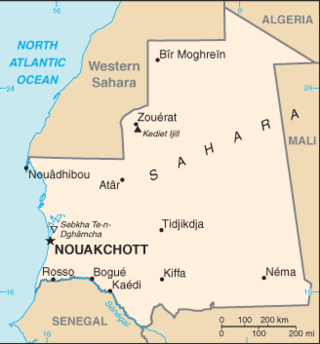
A military coup took place in Mauritania on 3 August 2005. The President Maaouya Ould Sid'Ahmed Taya was ousted by the Armed Forces of Mauritania and replaced by the Military Council for Justice and Democracy (CMJD), headed by Ely Ould Mohamed Vall, while Taya was in Saudi Arabia attending the funeral of King Fahd of Saudi Arabia. A constitutional referendum, parliamentary and presidential elections were scheduled and the coup leaders vowed not to contest any of the elections. The military government ended with the presidential election on 11 March 2007 as promised.

The Military Committee for National Salvation was a military Government of Mauritania that took power in the 1979 coup d'état. It was installed by Mohamed Khouna Ould Haidalla, Ahmed Ould Bouceif and fellow officers, in an internal regime/military coup on April 6, 1979, removing Colonel Mustafa Ould Salek of the Military Committee for National Recovery (CMRN) from effective power. He was officially replaced by Mohamed Mahmoud Ould Louly in June 1979. Haidalla would later emerge as the main military strongman and go on to assume full powers in the 1980 coup d'état, only to be deposed by Colonel Maaouya Ould Sid'Ahmed Taya in the December 1984 coup d'état.
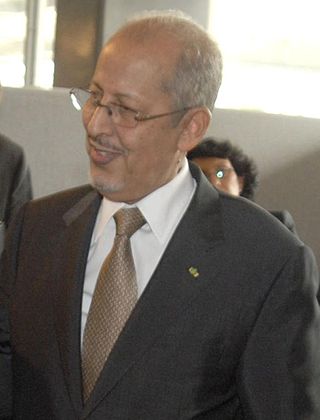
Sidi Mohamed Ould Cheikh Abdallahi was a Mauritanian politician who was President of Mauritania from 2007 to 2008. He served in the government during the 1970s, and after a long period of absence from politics he won the March 2007 presidential election, taking office on 19 April 2007. He was deposed in a military coup d'état on 6 August 2008.
Zeine Ould Zeidane is a Mauritanian economist and politician. He placed third as a candidate in the March 2007 presidential election, and he subsequently served as Prime Minister from April 2007 to May 2008.
Saleh Ould Hanenna is a former Mauritanian soldier and political figure.
In December 1984, Haidallah was deposed by Colonel Maaouya Ould Sid'Ahmed Taya, who, while retaining tight military control, relaxed the political climate. Ould Taya moderated Mauritania's previous pro-Algerian stance, and re-established ties with Morocco during the late 1980s. He deepened these ties during the late 1990s and early 2000s as part of Mauritania's drive to attract support from Western states and Western-aligned Arab states. Mauritania has not rescinded its recognition of Polisario's Western Saharan exile government and remains on good terms with Algeria. Its position on the Western Sahara conflict has been, since the 1980s, one of strict neutrality.
Mohamed Lemine Ould Guig is a Mauritanian academic and political figure. He was the 8th Prime Minister of Mauritania from December 18, 1997, to November 16, 1998.

Mohamed Ould Abdel Aziz is a former Mauritanian politician who was the 8th president of Mauritania from 2009 to 2019.
The mass media in Mauritania is undergoing a shift into a freer journalistic environment, while becoming increasingly open to private sector.
Yahya Ould Hademine is a Mauritanian engineer and politician who served as Defense Minister of Mauritania. He served as the Prime Minister of Mauritania from August 21, 2014 to October 29, 2018.
The following is a timeline of the history of the city of Niamey, Niger.
Ahmed Salim Ould Sidi was a Mauritanian military officer and political leader and acting Prime Minister of Mauritania between 28 and 31 May 1979.
The Attack on Tichla took place on July 12, 1979, in the town of Tichla, in Western Sahara. It marks the final conflict between Mauritania and Polisario before the peace treaty in Algiers and Mauritania's withdrawal from the conflict.











